Study on New Natural Ventilation Performance Based on Seat Air Supply in Gymnasiums
Abstract
1. Introduction
2. Study Site and Measurements
2.1. Research Area
2.1.1. Location
2.1.2. Climate Information
2.2. Field Measurement
2.2.1. Measurement Object
2.2.2. Measurement Schedule and Instruments
2.2.3. Measurement Results
3. Results and Discussion
3.1. Comparison of Simulation and Experimental Results
3.1.1. Simulation Model
3.1.2. Consistency Verification Between Simulation Results and Experimental Results
3.2. The Influence of the Opening Rate on the Indoor Wind Environment
3.2.1. Case Model
3.2.2. The Impact of the Equipment Activation Rate on Indoor Grandstand Areas
3.2.3. The Impact of Device Activation Rate on Indoor Sports Areas
3.3. Discussion
4. Conclusions
- During the period when the seat air supply system is turned off, the maximum indoor–outdoor temperature difference is 1.7 °C, which proves that the sports venues’ exterior walls have good thermal insulation properties, helping to maintain a comfortable indoor temperature. After the seat air supply system is turned on, the maximum indoor–outdoor temperature difference increases to 3.4 °C, indicating that the activation of the seat air supply system further reduces the indoor temperature.
- When the seat air supply is turned off, the wind speed in the seat area is almost zero. The opening of the seat air supply significantly increases the wind speed in the seat area, improving the natural ventilation effect. Meanwhile, the uniformity of the wind speed field in the sports areas also increases significantly with the opening of the seat air supply device, which is conducive to the creation of a good indoor environment.
- When the temperature of the indoor stand is low (10:00 am), the opening of the seat ventilation device causes a significant change in the PMV index of the front seat area, and the average reduction in the four directions is 0.39. The seating area on the south side changed the most, from 1.15 before the device was turned off to 0.56. The seating area on the north side changed the least, from 1.16 before the device was turned off to 0.92. When the temperature of the indoor stand reaches the maximum, the influence of the device opening on the PMV index of the seat area is small, and the average reduction is only 0.19.
- This study only investigates the application effect of a natural wind-driven seat air supply in gymnasiums. Its application in more types of buildings remains to be studied. The application of nature-driven seat air supply in stadiums is very promising and can effectively promote the development of low-carbon undertakings.
Author Contributions
Funding
Data Availability Statement
Conflicts of Interest
Abbreviations
| ACH | Air-change rate |
| CFD | Computational fluid dynamics |
| TVOC | Total Volatile Organic Compounds |
| PM | Particulate matter |
| ME | Mean Error |
| RMSE | Root Mean Square Error |
| PMV | Predicted Mean Vote |
| ST | Temperature of the indoor stand |
References
- Ke, Y. Research on energy-saving strategies of college stadiums and sports venues under the concept of low carbon development. E3S Web Conf. EDP Sci. 2021, 275, 02007. [Google Scholar] [CrossRef]
- Alves, C.A.; Calvo, A.I.; Castro, A.; Fraile, R.; Evtyugina, M.; Bate-Epey, E.F. Air quality in sports venues with distinct characteristics. Int. J. Environ. Ecol. Eng. 2013, 7, 298–302. [Google Scholar] [CrossRef]
- Bralewska, K.; Rogula-Kozłowska, W. Health exposure of users of indoor sports centers related to the physico-chemical properties of particulate matter. Build. Environ. 2020, 18, 106935. [Google Scholar] [CrossRef]
- Kuskowska, K.; Rogula-Kozłowska, W.; Widziewicz, K. A preliminary study of the concentrations and mass size distributions of particulate matter in indoor sports facilities before and during athlete training. Environ. Protect. Eng. 2019, 3, 103–112. [Google Scholar] [CrossRef]
- Sracic, M.K. Modeled regional airway deposition of inhaled particles in athletes at exertion. J. Aerosol Sci. 2016, 99, 54–63. [Google Scholar] [CrossRef]
- Abelsohn, A.; Stieb, D.M. Health effects of outdoor air pollution. Approach to counseling patients using the Air Quality Health Index. Can. Fam. Physician 2011, 57, 881–887. [Google Scholar]
- Flaherty, J.M.; Smoliga, J.M.; Zavorsky, G.S. The effect of increased physical activity on pulmonary diffusing capacity in unfit women. Exp. Physiol. 2014, 99, 562–570. [Google Scholar] [CrossRef]
- Qian, F.; Shi, Z.; Yang, L. A Review of Green, Low-Carbon, and Energy-Efficient Research in Sports Buildings. Energies 2024, 17, 4020. [Google Scholar] [CrossRef]
- Yang, D.; Li, P. Natural ventilation of lower-level floors assisted by the mechanical ventilation of upper-level floors via a stack. Energy Build. 2015, 92, 296–305. [Google Scholar] [CrossRef]
- Moosavi, L.; Mahyuddin, N.; Ab Ghafar, N.; Ismail, M.A. Thermal performance of atria: An overview of natural ventilation effective designs. Renew. Sustain. Energy Rev. 2014, 34, 654–670. [Google Scholar] [CrossRef]
- Rajagopalan, P.; Luther, M.B. Thermal and ventilation performance of a naturally ventilated sports hall within an aquatic centre. Energy Build. 2013, 58, 111–122. [Google Scholar] [CrossRef]
- Nguyen, S. Thermal Comfort in Indoor Sports Facilities and the Adequacy of Demand-controlled Ventilation. Master’s Thesis, Aalto University, Espoo, Finland, 2023. [Google Scholar]
- Zhong, H.Y.; Sun, Y.; Shang, J.; Qian, F.P.; Zhao, F.Y.; Kikumoto, H.; Jimenez-Bescos, C.; Liu, X. Single-sided natural ventilation in buildings: A critical literature review. Build. Environ. 2022, 212, 108797. [Google Scholar] [CrossRef]
- Kulmala, I.; Hynynen, P.; Welling, I.; Säämänen, A. Local ventilation solution for large, warm emission sources. Ann. Occup. Hyg. 2007, 51, 35–43. [Google Scholar]
- Khan, N.; Su, Y.; Riffat, S.B. A review on wind driven ventilation techniques. Energy Build. 2008, 40, 1586–1604. [Google Scholar] [CrossRef]
- Haw, L.C.; Saadatian, O.; Sulaiman, M.Y.; Mat, S.; Sopian, K. Empirical study of a wind-induced natural ventilation tower under hot and humid climatic conditions. Energy Build. 2012, 52, 28–38. [Google Scholar] [CrossRef]
- Qian, F.; Shi, Z.; Yang, L. Thinking of Green, Low Carbon, and Energy-Saving Designs Based on the Variable Ventilation of Natatoriums: Taking the Jiading Natatorium of Tongji University as an Example. Sustainability 2024, 16, 4476. [Google Scholar] [CrossRef]
- Kang, J.H.; Lee, S.J. Improvement of natural ventilation in a large factory building using a louver ventilator. Build. Environ. 2008, 43, 2132–2141. [Google Scholar] [CrossRef]
- Cui, S.; Stabat, P.; Marchio, D. Numerical simulation of wind-driven natural ventilation: Effects of loggia and facade porosity on air change rate. Build. Environ. 2016, 106, 131–142. [Google Scholar] [CrossRef]
- Lin, J.T.; Chuah, Y.K. A study on the potential of natural ventilation and cooling for large spaces in subtropical climatic regions. Build. Environ. 2011, 46, 89–97. [Google Scholar] [CrossRef]
- Huang, C.; Zou, Z.; Li, M.; Wang, X.; Li, W.; Huang, W.; Yang, J.; Xiao, X. Measurements of indoor thermal environment and energy analysis in a large space building in typical seasons. Build. Environ. 2007, 42, 1869–1877. [Google Scholar] [CrossRef]
- Karaiskos, P.; Martinez-Molina, A.; Alamaniotis, M. Analyzing indoor air pollutants in naturally ventilated athletic facilities. A case of study. J. Build. Eng. 2023, 77, 107457. [Google Scholar] [CrossRef]
- Cheng, Z.; Li, L.; Bahnfleth, W.P. Natural ventilation potential for gymnasia–Case study of ventilation and comfort in a multisport facility in northeastern United States. Build. Environ. 2016, 108, 85–98. [Google Scholar] [CrossRef]
- Guo, W.; Liang, S.; He, Y.; Li, W.; Xiong, B.; Wen, H. Combining EnergyPlus and CFD to predict and optimize the passive ventilation mode of medium-sized gymnasium in subtropical regions. Build. Environ. 2022, 207, 108420. [Google Scholar] [CrossRef]
- Sekhar, C.; Bivolarova, M.; Akimoto, M.; Wargocki, P. Detailed characterization of bedroom ventilation during heating season in a naturally ventilated semi-detached house and a mechanically ventilated apartment. Sci. Technol. Built Environ. 2020, 27, 158–180. [Google Scholar] [CrossRef]
- Cheng, Y.; Niu, J.; Gao, N. Stratified air distribution systems in a large lecture theatre: A numerical method to optimize thermal comfort and maximize energy saving. Energy Build. 2012, 55, 515–525. [Google Scholar] [CrossRef]
- Zítek, P.; Vyhlídal, T.; Simeunović, G.; Nováková, L.; Čížek, J. Novel personalized and humidified air supply for airliner passengers. Build. Environ. 2010, 45, 2345–2353. [Google Scholar] [CrossRef]
- Heinsohn, R.J.; O’Donnel, W.R.; Tao, J. Automobile passenger compartment ventilation. Ashrae Trans. 1993, 99, 3669. [Google Scholar]
- White, J.H. The American Railroad Passenger Car; JHU Press: Baltimore, MD, USA, 1985. [Google Scholar]
- Dobruszkes, F. High-speed rail and air transport competition in Western Europe: A supply-oriented perspective. Transp. Policy 2011, 18, 870–879. [Google Scholar] [CrossRef]
- Zhang, T.; Chen, Q.Y. Novel air distribution systems for commercial aircraft cabins. Build. Environ. 2007, 42, 1675–1684. [Google Scholar] [CrossRef]
- Yan, W.; Zhang, Y.; Sun, Y.; Li, D. Experimental and CFD study of unsteady airborne pollutant transport within an aircraft cabin mock-up. Build. Environ. 2009, 44, 34–43. [Google Scholar] [CrossRef]
- Niu, J.; Gao, N.; Phoebe, M.; Huigang, Z. Experimental study on a chair-based personalized ventilation system. Build. Environ. 2007, 42, 913–925. [Google Scholar] [CrossRef]
- Kwon, Y.I. A Study on the Improvement of ADPI and Ventilation Effectiveness in a Small Theater. Int. J. Air-Cond. Refrig. 2016, 24, 1650019. [Google Scholar] [CrossRef]
- Bolashikov, Z.; Melikov, A.; Krenek, M. Control of the free convective flow around the human body for enhanced inhaled air quality: Application to a seat-incorporated personalized ventilation unit. HvacR Res. 2010, 16, 161–188. [Google Scholar] [CrossRef]
- Gao, R.; Li, H.; Li, A.; Lai, T.; Du, W.; Deng, B.; Zhang, L.; Lei, W. Guardrail-based air supply terminal for improving ventilation effectiveness and saving energy in the waiting zone. Energy Explor. Exploit. 2021, 39, 1394–1414. [Google Scholar] [CrossRef]
- Gao, N. Numerical and experimental study of personalized ventilation. Ph.D. Thesis, The Hong Kong Polytechnic University, Hong Kong, China, 2007. [Google Scholar]
- Zhang, Y.; Wu, X.; Zhang, J.; Pan, Z. Study on the Design Schemes of the Air-Conditioning System in a Gymnasium. In Proceedings of the 2nd International Conference on Materials Science, Energy Technology and Environmental Engineering (MSETEE 2017), Zhuhai, China, 28–30 April 2017; IOP Publishing: Bristol, UK, 2017; Volume 81, p. 012158. [Google Scholar]
- Nishioka, T.; Ohtaka, K.; Hashimoto, N.; Onojima, H. Measurement and evaluation of the indoor thermal environment in a large domed stadium. Energy Build. 2000, 32, 217–223. [Google Scholar] [CrossRef]
- Stathopoulou, O.I.; Assimakopoulos, V.D.; Flocas, H.A.; Helmis, C.G. An experimental study of air quality inside large athletic halls. Build. Environ. 2008, 43, 834–848. [Google Scholar] [CrossRef]
- Fokaides, P.A.; Jurelionis, A.; Gagyte, L.; Kalogirou, S.A. Mock target IR thermography for indoor air temperature measurement. Appl. Energy 2016, 164, 676–685. [Google Scholar] [CrossRef]
- Wang, K.; Li, Q.; Yang, Y. Energy Saving Simulation Analysis of Natural Cooling of Fresh Air in Small and Medium-Sized Data Centers in Cold Winter and Hot Summer Regions. In Proceedings of the 2nd International Conference on Computer Engineering and Intelligent Control (ICCEIC),IEEE, Chongqing, China, 12–14 November 2021; pp. 201–204. [Google Scholar]
- Raji, B.; Tenpierik, M.J.; Bokel, R.; van den Dobbelsteen, A. Natural summer ventilation strategies for energy-saving in high-rise buildings: A case study in the Netherlands. Int. J. Vent. 2020, 19, 25–48. [Google Scholar] [CrossRef]
- Gang, Z.; Shuting, Y.; Fenglong, W. Study of the Urban Coordinated Development Capability Index in the Yangtze River Economic Belt. J. Landsc. Res. 2020, 12, 41. [Google Scholar]
- Li, Z.; Jiao, L.; Zhang, B.; Xu, G.; Liu, J. Understanding the pattern and mechanism of spatial concentration of urban land use, population and economic activities: A case study in Wuhan, China. Geo-Spat. Inf. Sci. 2021, 24, 678–694. [Google Scholar] [CrossRef]
- Wang, L.; Wang, K.; Zhang, J.; Zhang, D.; Wu, X.; Zhang, L. Multiple objective-oriented land supply for sustainable transportation: A perspective from industrial dependence, dominance and restrictions of 127 cities in the Yangtze River Economic Belt of China. Land Use Policy 2020, 99, 105069. [Google Scholar] [CrossRef]
- Lee, M.; Park, G.; Park, C.; Kim, C. Improvement of grid independence test for computational fluid dynamics model of building based on grid resolution. Adv. Civ. Eng. 2020, 2020, 8827936. [Google Scholar] [CrossRef]
- Fisher, R.A. A Mathematical Examination of the Methods of Determining the Accuracy of an Observation by the Mean Error, and by the Mean Square Error. Mon. Not. R. Astron. Soc. 1920, 80, 758–770. [Google Scholar] [CrossRef]
- Hodson, T.O. Root mean square error (RMSE) or mean absolute error (MAE): When to use them or not. Geosci. Model Dev. Discuss. 2022, 15, 5481–5487. [Google Scholar] [CrossRef]
- Farris, J.S. The retention index and the rescaled consistency index. Cladistics 1989, 5, 417–419. [Google Scholar] [CrossRef]
- Uğursal, A.; Culp, C.H. The effect of temperature, metabolic rate and dynamic localized airflow on thermal comfort. Appl. Energy 2013, 111, 64–73. [Google Scholar] [CrossRef]
- Ji, T.; Cai, J.; Wang, K. Investigation on the indoor thermal comfort in sports settings and an improvement to Fanger model. Int. J. Low-Carbon Technol. 2022, 17, 333–341. [Google Scholar] [CrossRef]
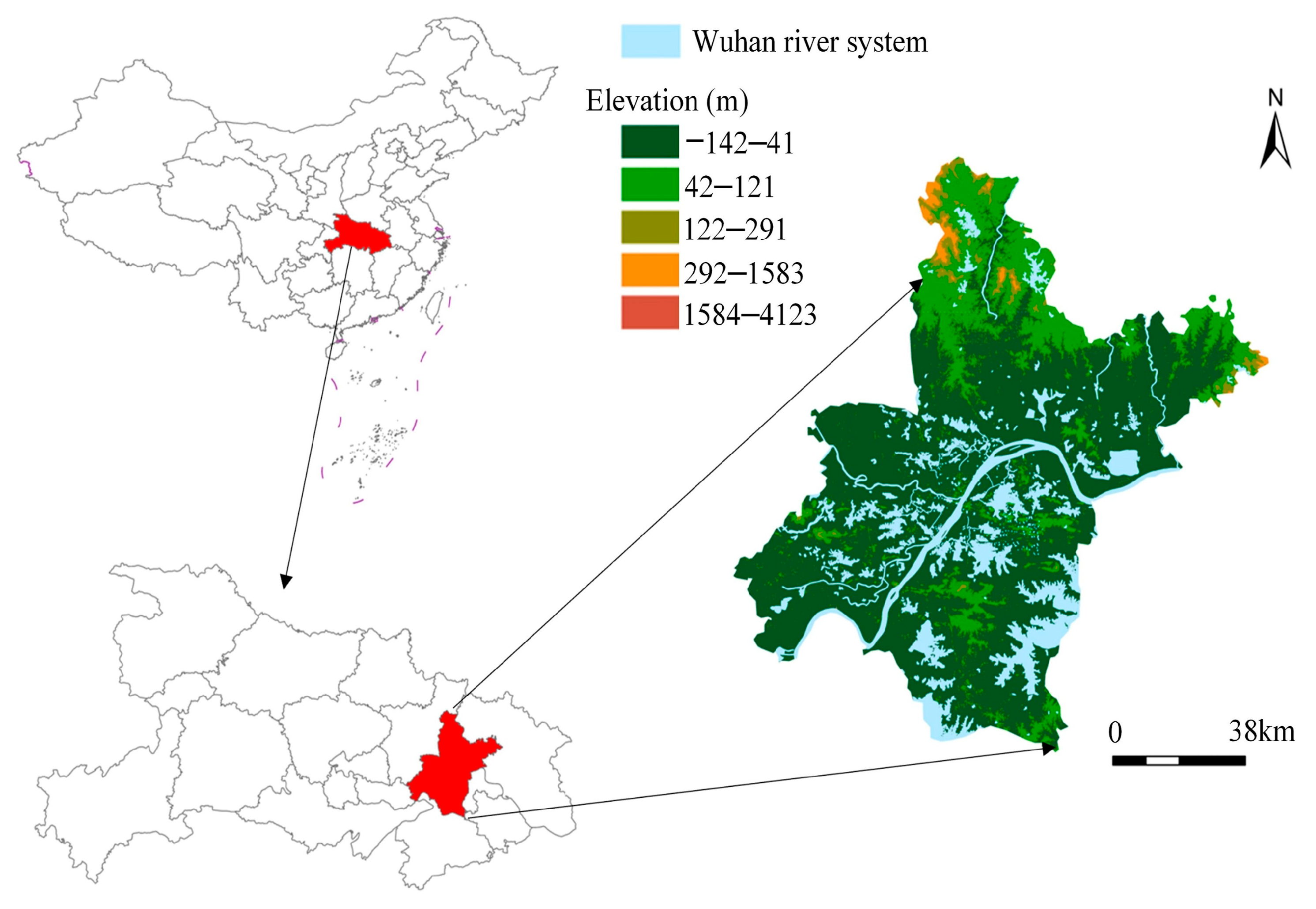


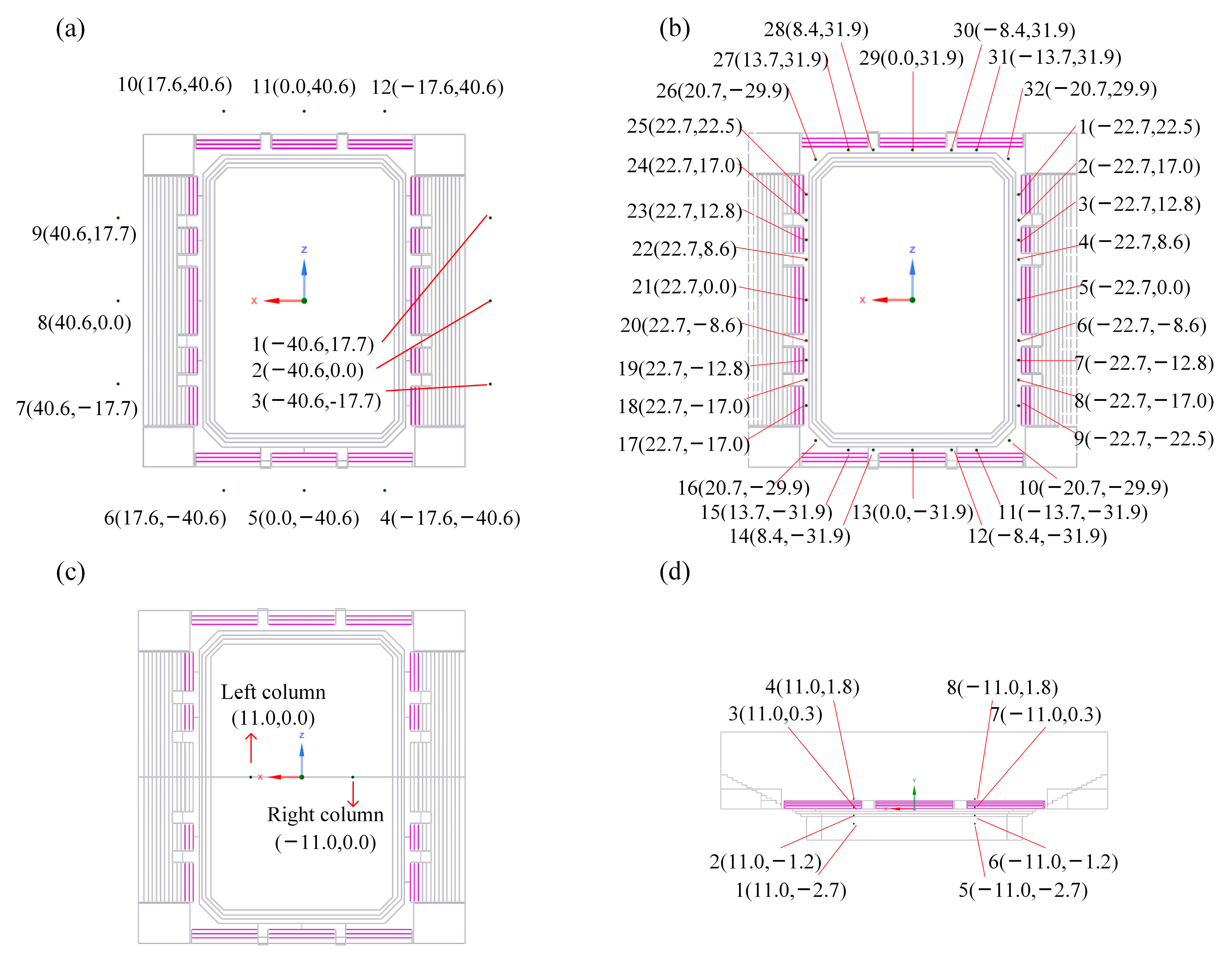
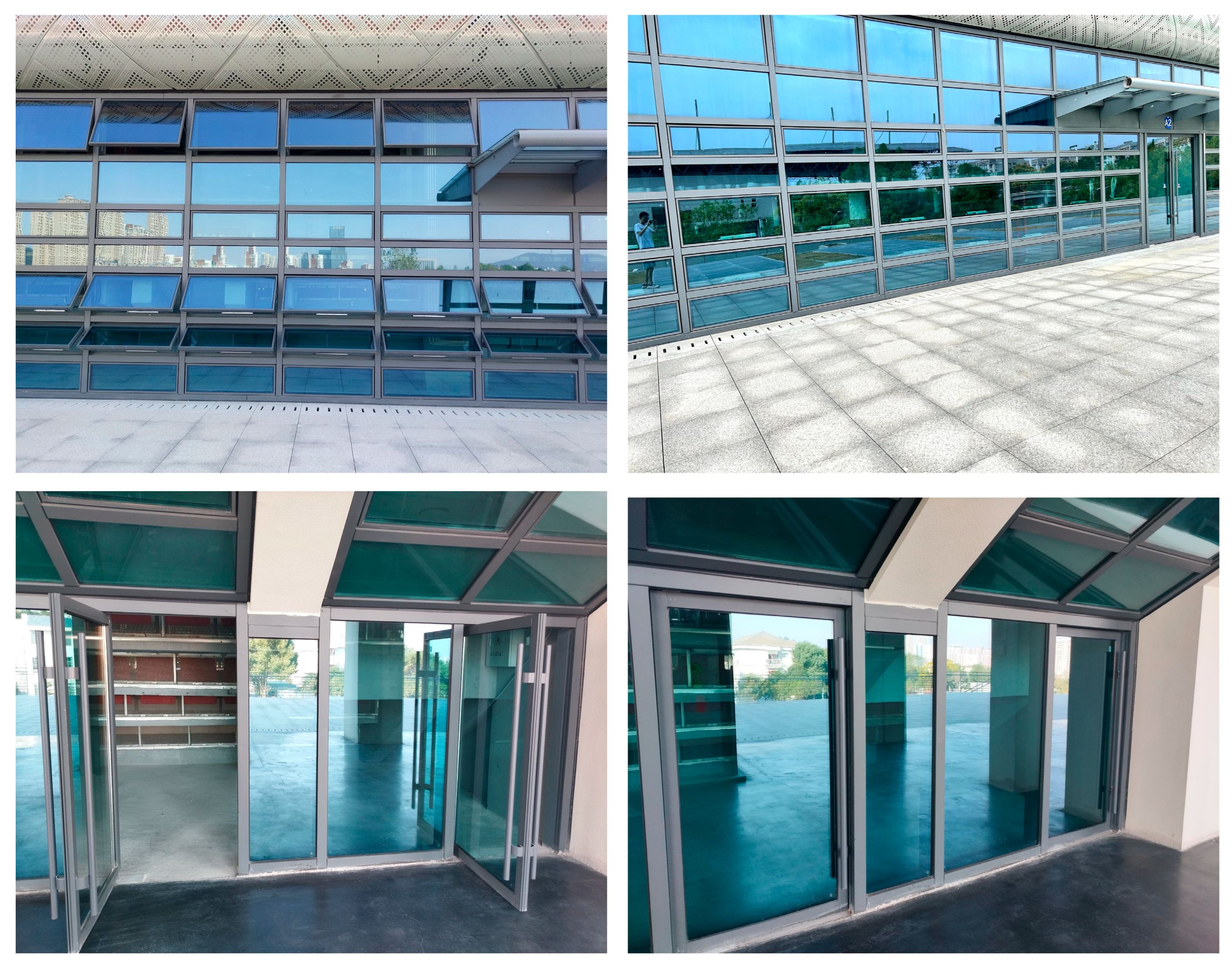

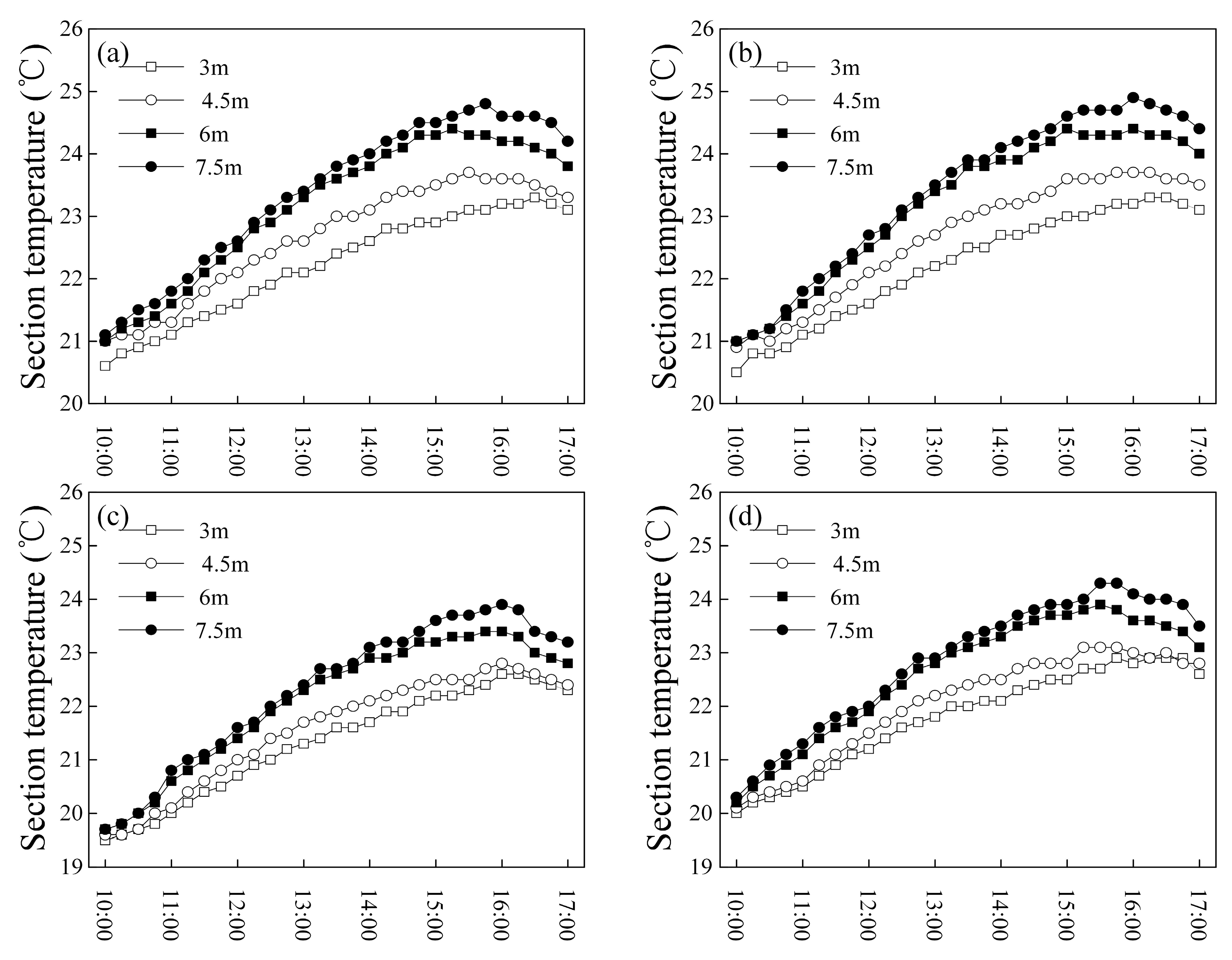
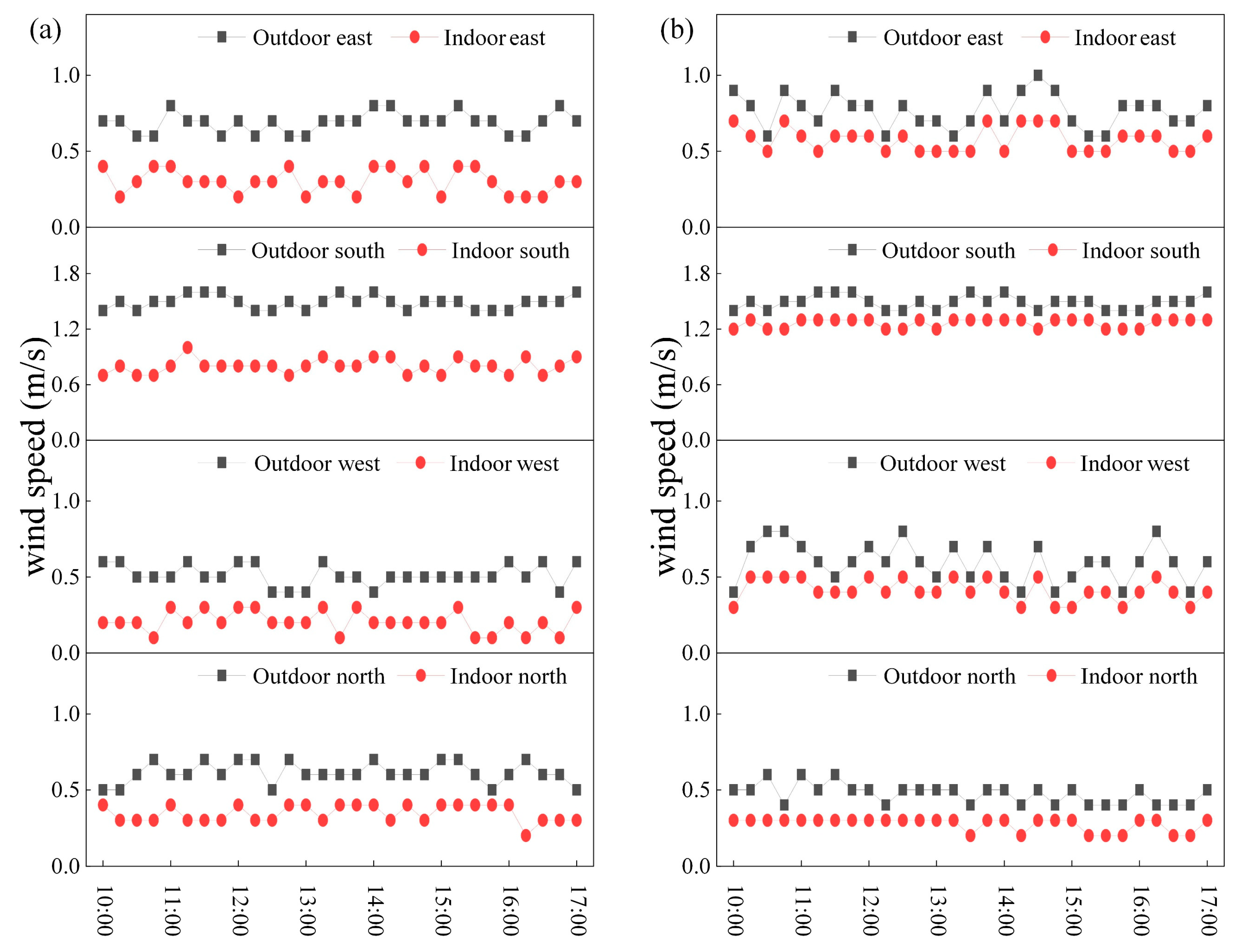
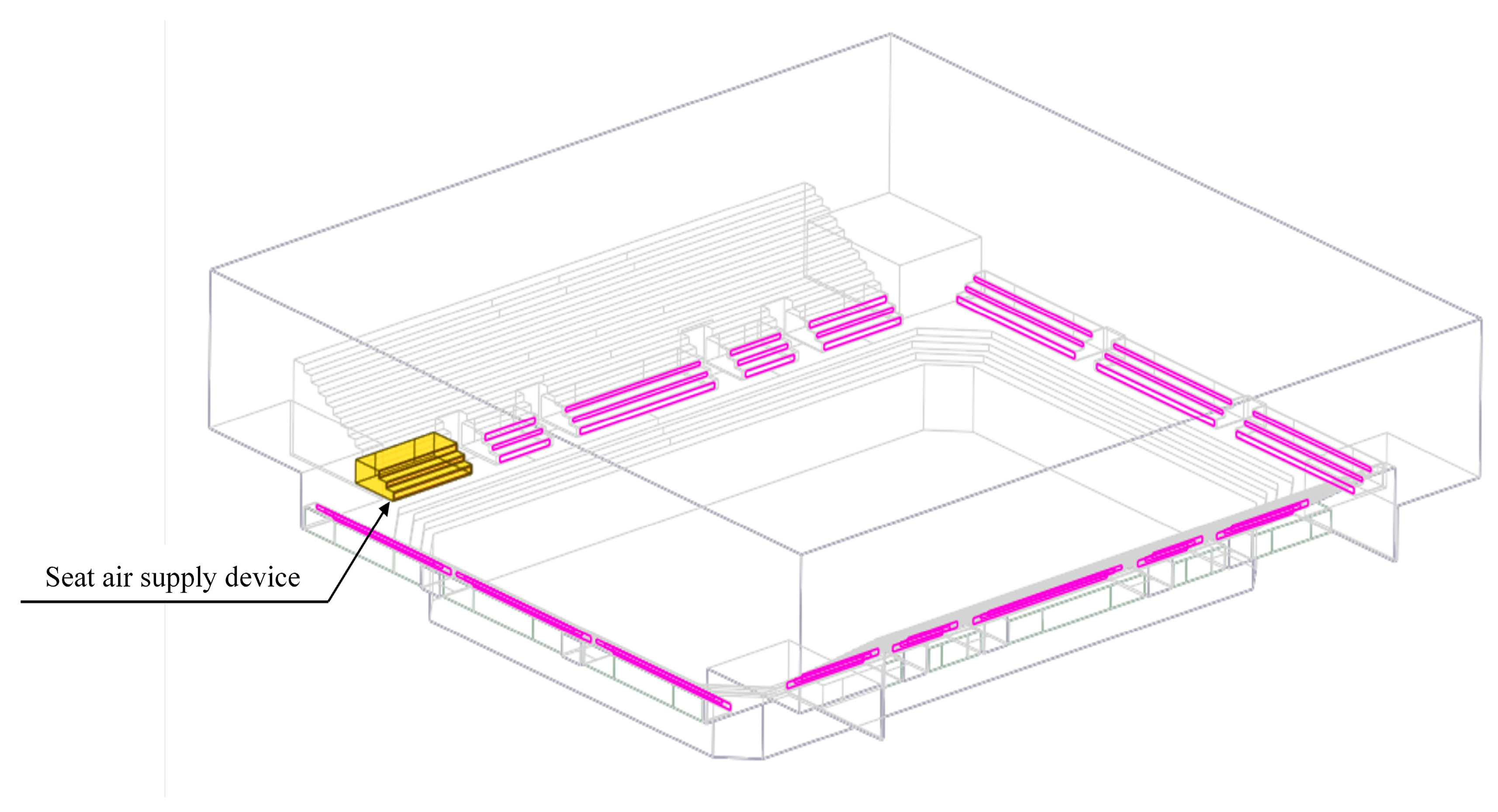
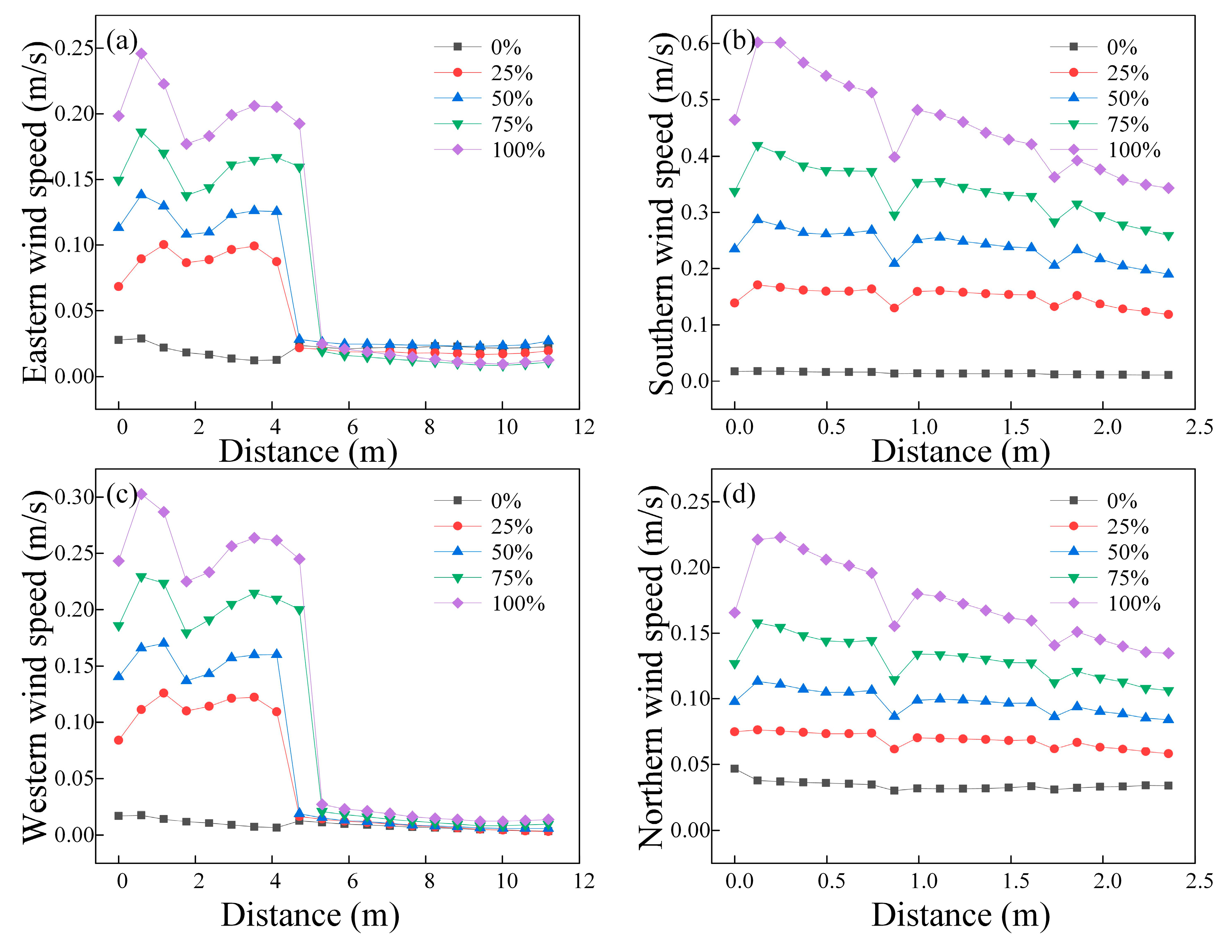
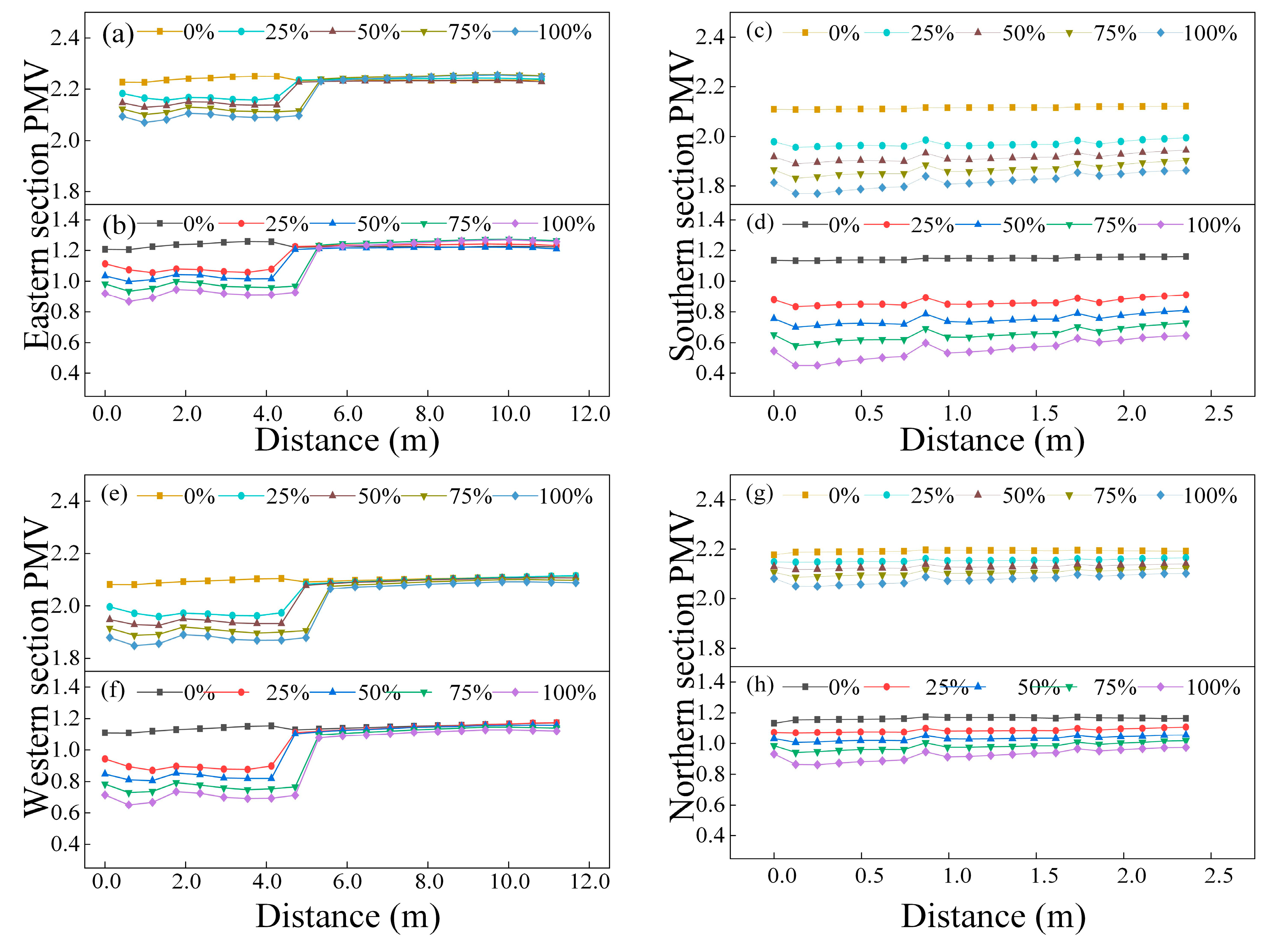
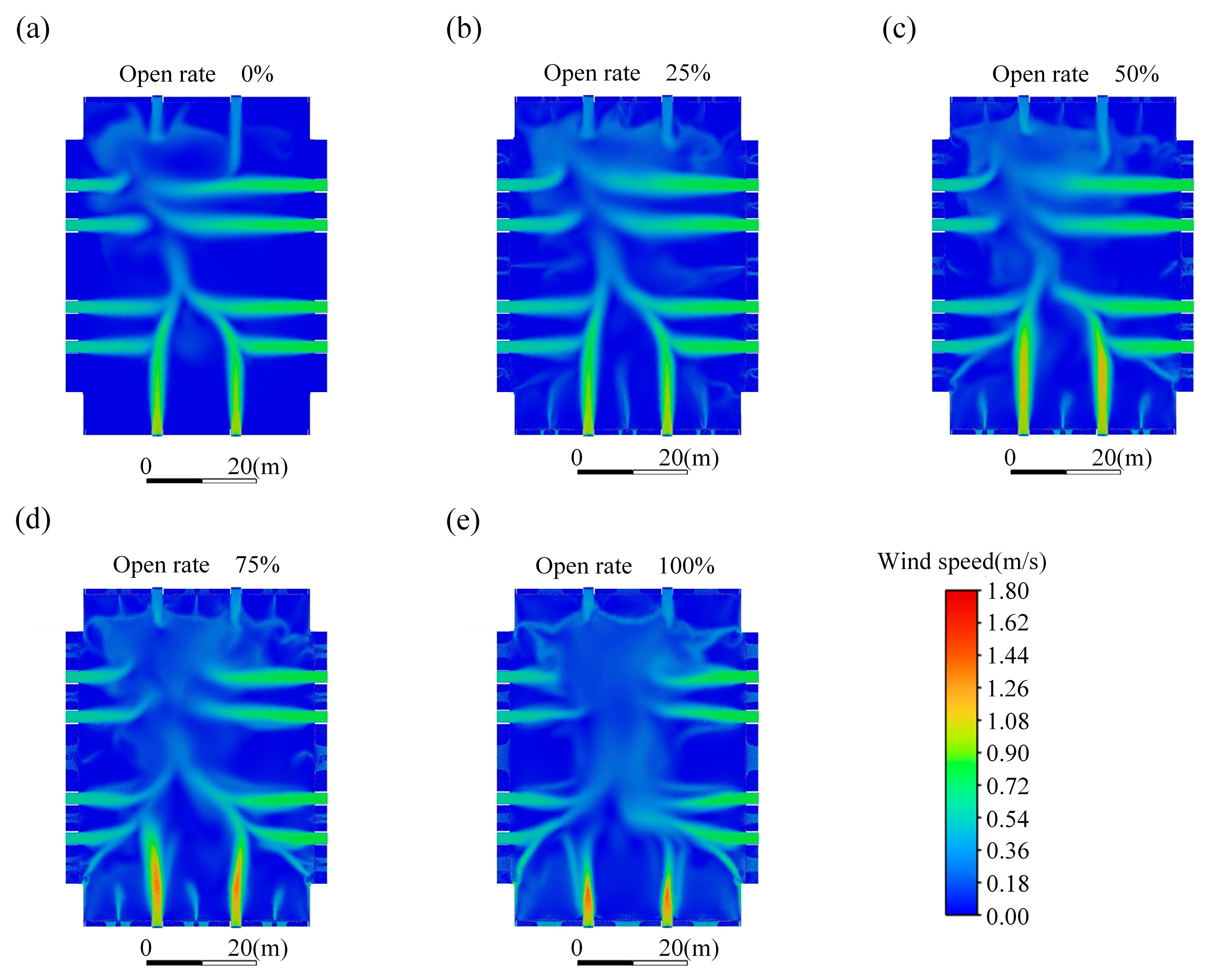
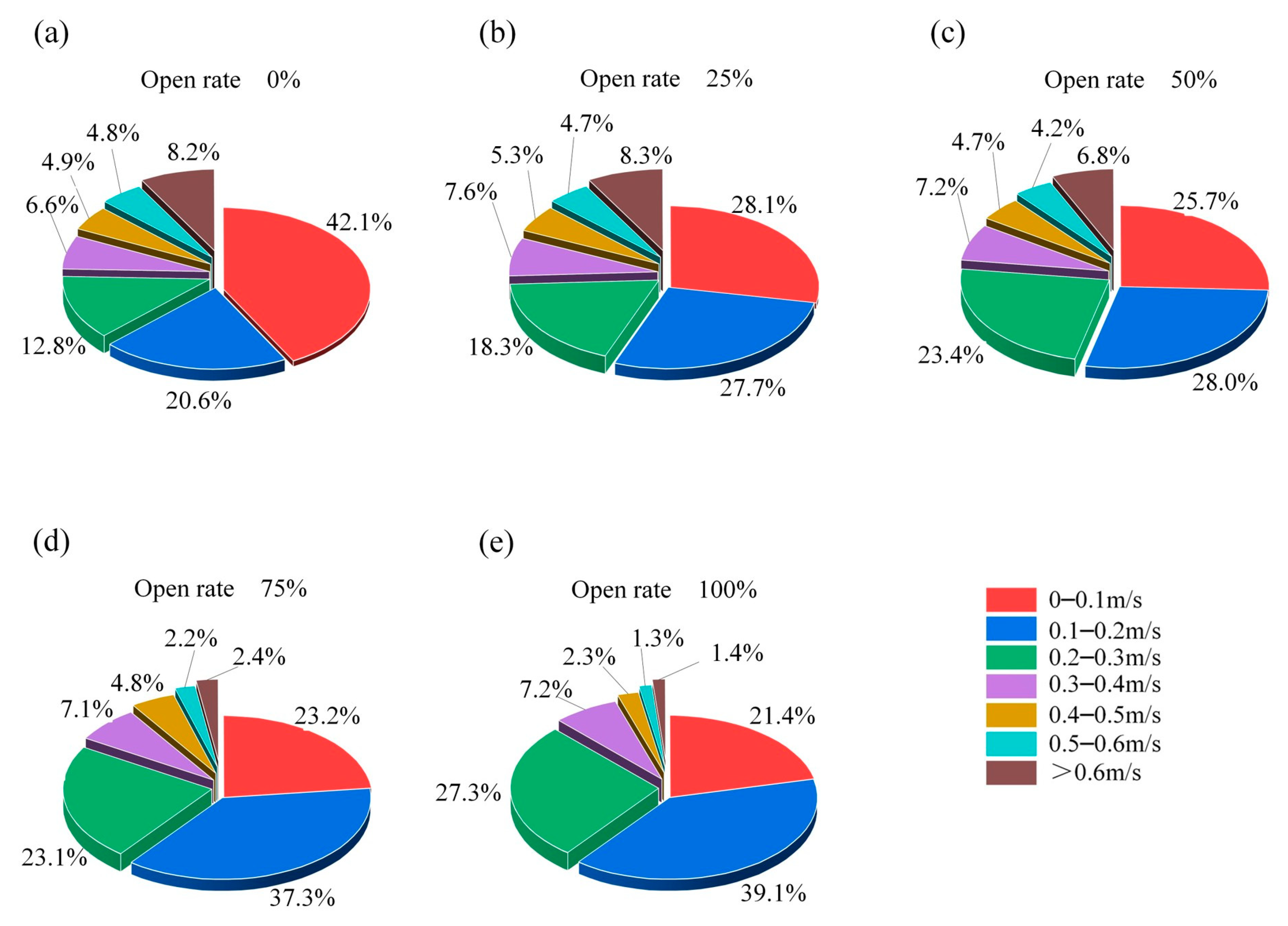
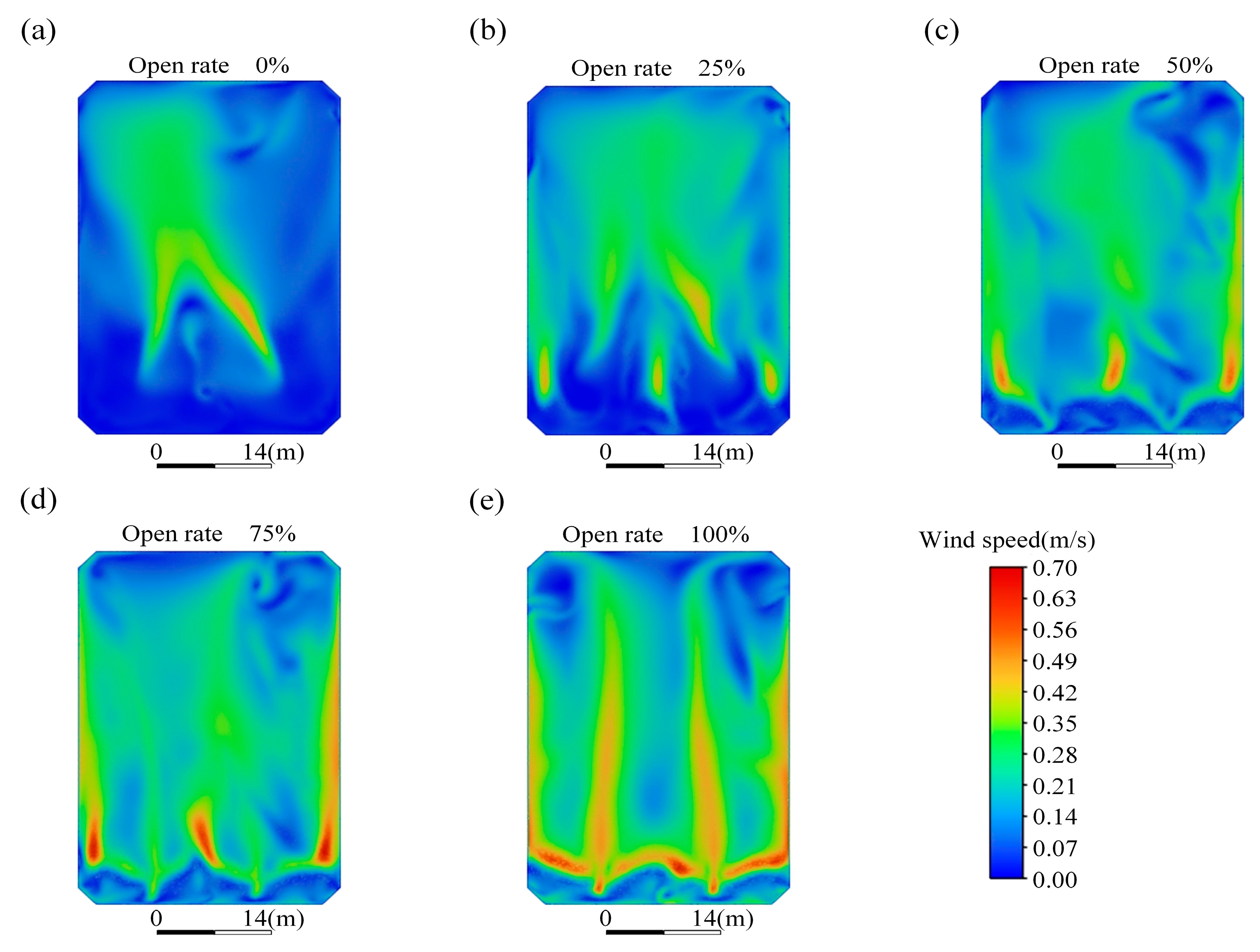

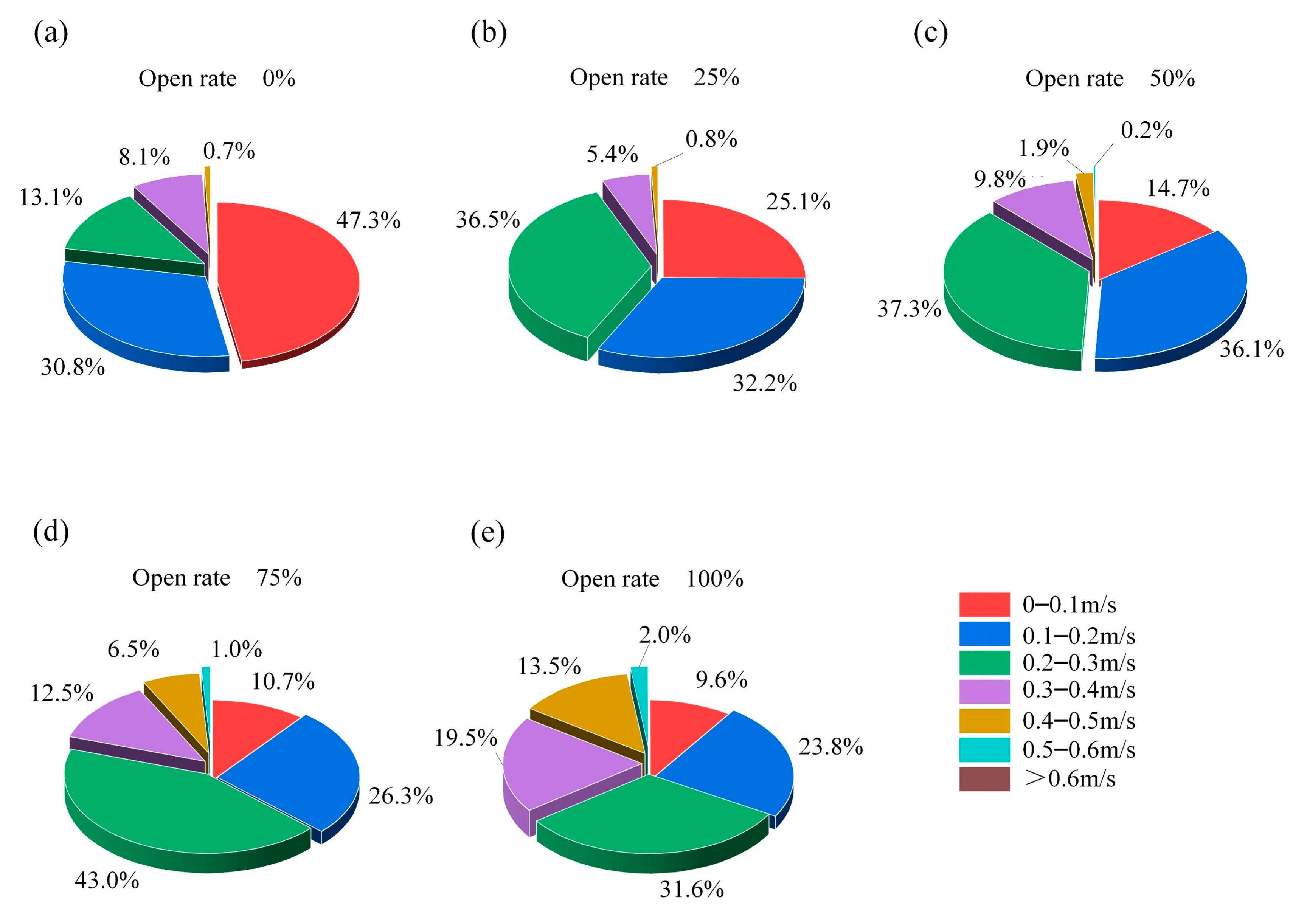
| Scholar | Advantage | Disadvantage | ||
|---|---|---|---|---|
| Natural ventilation | Wind-induced ventilation tower | Haw et al. [16] | Ventilation performance can be maintained when the temperature difference between the indoors and outdoors is not large. | Depending on wind and direction, there is a risk of rainwater flooding. |
| Opening at the top | Qian et al. [17] Lin et al. [20] Chen et al. [21] Cheng et al. [23] | Flexible and controllable ventilation adjustment, making full use of thermal pressure ventilation. | The structure is relatively complex, and the construction and maintenance costs are high. | |
| External deflector louver | Kang et al. [18] | Suitable for places where the wind is stable; the guidance of the blade increases the flow of the sucked air and takes into account the protection of the place. | The design optimization is rather complex. | |
| The window opening corresponding to the prevailing wind direction | Cui et al. [19] | The wind pressure utilization is maximized, and the structure is simple. | The heat preservation performance is affected. It increases the incoming solar radiation. | |
| Seat air supply driven by natural wind | This manuscript | The airflow is guided to blow directly onto the user, enhancing local comfort. The structure is simple, and the maintenance cost is low. | High environmental dependence. | |
| Mechanical ventilation | Ventilator | Sekhar et al. [25] | High controllability and stability; flexible adaptation to complex scenarios. | High energy consumption, and operating cost; noise. |
| Seat air supply | Cheng et al. [26] Zítek et al. [27] Zhang et al. [38] Nishioka et al. [39] | With the air conditioning system, it can effectively reduce or increase the local temperature and save energy. | The energy consumption is still higher than that of natural ventilation, and the maintenance complexity is relatively high. |
| Parameter | Measurement Instrument | Precision Accuracy | Sampling Frequency |
|---|---|---|---|
| Temperature | HOBO Pro Temperature Recorder | ±0.1 °C | 15-min interval |
| Relative humidity | ±2% | ||
| Wind speed | TSI-AP500 wireless anemometer | ±2% |
| Condition 1 | Condition 2 | Condition 3 | Condition 4 | |
|---|---|---|---|---|
| Date | 22 April | 23 April | 24 April | 25 April |
| Power sunroof | ON | ON | ON | ON |
| Seat air supply device | OFF | OFF | ON | ON |
| First floor entrance | OFF | OFF | OFF | OFF |
| Second floor entrance | ON | ON | ON | ON |
| East Outdoor/ Indoor (m/s) | South Outdoor/ Indoor (m/s) | West Outdoor/ Indoor (m/s) | North Outdoor/ Indoor (m/s) | Air intake Rate | |
|---|---|---|---|---|---|
| 22 April | 1.2/0.6 | 1.1/0.4 | 0.5/0.3 | 0.6/0.3 | 47% |
| 23 April | 0.7/0.3 | 1.5/0.8 | 0.5/0.2 | 0.6/0.3 | 48% |
| 24 April | 0.8/0.6 | 1.4/1.1 | 0.6/0.5 | 0.5/0.3 | 75% |
| 25 April | 1.1/0.8 | 0.4/0.2 | 0.5/0.3 | 1.2/0.9 | 69% |
| East Outdoor/ Indoor | South Outdoor/ Indoor | West Outdoor/ Indoor | North Outdoor/ Indoor | Change in Relative Humidity | |
|---|---|---|---|---|---|
| 22 April | 71%/63% | 72%/64% | 73%/62% | 71%/62% | 9.25% |
| 23 April | 71%/65% | 71%/66% | 71%/64% | 71%/62% | 6.75% |
| 24 April | 72%/71% | 71%/70% | 72%/71% | 73%/72% | 1% |
| 25 April | 56%/56% | 59%/58% | 56%/55% | 57%/56% | 0.75% |
| — | East (m/s) | South (m/s) | West (m/s) | North (m/s) | Air Intake Rate | |
|---|---|---|---|---|---|---|
| OFF | simulated value | 0.56 | 0.34 | 0.31 | 0.24 | 42.59% |
| measured value | 0.6 | 0.4 | 0.3 | 0.3 | 47.00% | |
| ON | simulated value | 0.66 | 0.99 | 0.45 | 0.36 | 74.34% |
| measured value | 0.6 | 1.1 | 0.5 | 0.3 | 75.00% |
| Seat Air Supply | — | Value |
|---|---|---|
| OFF | ME | 0.04 |
| d | 0.89 | |
| RMSE | 0.05 | |
| ON | ME | 0.09 |
| d | 0.90 | |
| RMSE | 0.11 |
| Title 1 | Title 2 | Natural Ventilation Opening Rate | Outdoor Wind Speed (m/s) | |||||
|---|---|---|---|---|---|---|---|---|
| Case | Model | Seat air supply | Second floor entrance | Skylight window | East | South | West | North |
| 1 | Standard k-e | 0% | 100% | 100% | 0.8 | 1.4 | 0.6 | 0.5 |
| 2 | 25% | 100% | 100% | 0.8 | 1.4 | 0.6 | 0.5 | |
| 3 | 50% | 100% | 100% | 0.8 | 1.4 | 0.6 | 0.5 | |
| 4 | 75% | 100% | 100% | 0.8 | 1.4 | 0.6 | 0.5 | |
| 5 | 100% | 100% | 100% | 0.8 | 1.4 | 0.6 | 0.5 | |
| 6 | 0% | 100% | 100% | 1.2 | 1.1 | 0.5 | 0.6 | |
| Thermal Sensation | Hot | Warm | Slightly Warm | Neutral | Slightly Cool | Cool | Cold |
|---|---|---|---|---|---|---|---|
| PMV | +3 | +2 | +1 | 0 | −1 | −2 | −3 |
Disclaimer/Publisher’s Note: The statements, opinions and data contained in all publications are solely those of the individual author(s) and contributor(s) and not of MDPI and/or the editor(s). MDPI and/or the editor(s) disclaim responsibility for any injury to people or property resulting from any ideas, methods, instructions or products referred to in the content. |
© 2025 by the authors. Licensee MDPI, Basel, Switzerland. This article is an open access article distributed under the terms and conditions of the Creative Commons Attribution (CC BY) license (https://creativecommons.org/licenses/by/4.0/).
Share and Cite
Wu, Y.; Tang, W.; Wang, M.; Wang, Y.; Deng, Q. Study on New Natural Ventilation Performance Based on Seat Air Supply in Gymnasiums. Buildings 2025, 15, 1600. https://doi.org/10.3390/buildings15101600
Wu Y, Tang W, Wang M, Wang Y, Deng Q. Study on New Natural Ventilation Performance Based on Seat Air Supply in Gymnasiums. Buildings. 2025; 15(10):1600. https://doi.org/10.3390/buildings15101600
Chicago/Turabian StyleWu, Yinguang, Wensheng Tang, Meng Wang, Yimin Wang, and Qinli Deng. 2025. "Study on New Natural Ventilation Performance Based on Seat Air Supply in Gymnasiums" Buildings 15, no. 10: 1600. https://doi.org/10.3390/buildings15101600
APA StyleWu, Y., Tang, W., Wang, M., Wang, Y., & Deng, Q. (2025). Study on New Natural Ventilation Performance Based on Seat Air Supply in Gymnasiums. Buildings, 15(10), 1600. https://doi.org/10.3390/buildings15101600





